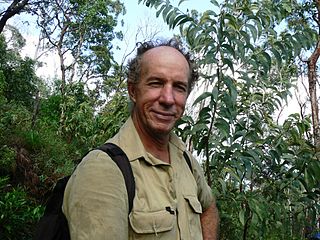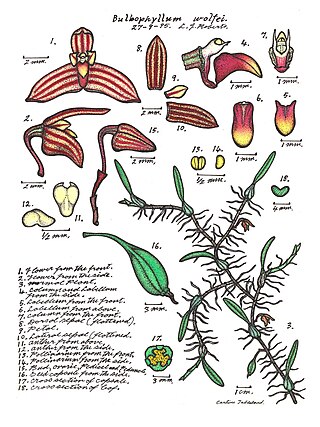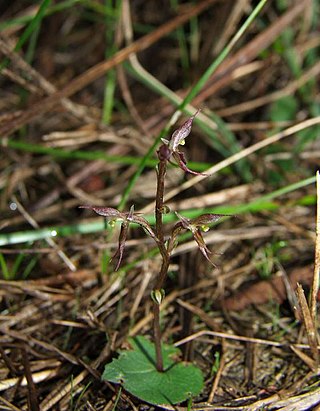
Acianthus, commonly known as mosquito orchids, is a genus of about twelve species of plants in the orchid family, Orchidaceae. Mosquito orchids are terrestrial herbs with a single, heart-shaped, usually ground-hugging leaf and one to many small, green, pinkish or purplish flowers on a fleshy stalk. They are found in New Caledonia, Australia and New Zealand.

Microtis, commonly known as onion orchids or mignonette orchids is a genus of about 20 species of plants in the orchid family, Orchidaceae. Onion orchids are terrestrial herbs with a single leaf at the base of the plant. They are similar to orchids in the genus Prasophyllum in that they have an onion-like leaf. The flowers are small but often scented and attractive to their insect pollinators. They are widespread in Asia, Australia and some Pacific islands.

Lewis Roberts, OAM, is a distinguished naturalist and botanical illustrator. Lewis and his brother, Charlie Roberts, are probably the leading experts on the flora and fauna of south-eastern part Cape York Peninsula and the northern Wet Tropics area. For three generations his family has lived at Shipton's Flat, about 45 km south of Cooktown, where he and Charlie were home-schooled. His father, Jack Lewis, was a tin miner and self-taught naturalist.

Dendrobium bigibbum, commonly known as the Cooktown orchid or mauve butterfly orchid, is an epiphytic or lithophytic orchid in the family Orchidaceae. It has cylindrical pseudobulbs, each with between three and five green or purplish leaves and arching flowering stems with up to twenty, usually lilac-purple flowers. It occurs in tropical North Queensland, Australia and New Guinea.
Bulbophyllum johnsonii, commonly known as the yellow snake orchid, is a species of epiphytic or lithophytic orchid that has a thin, creeping rhizome with flattened pseudobulbs, each with a single tough, dark green leaf and a single bright yellow to orange flower on a thread-like stalk. It grows on trees, shrubs and rocks in and near rainforest in tropical North Queensland.

Bulbophyllum wolfei, commonly known as the fleshy snake orchid, is a species of epiphytic or lithophytic orchid with thin, creeping rhizomes, and flattened pseudobulbs each with a single thick, fleshy, dark green leaf and a single cream-coloured flower with dark red stripes. It mostly grows on rainforest trees in tropical North Queensland.

Dendrobium trilamellatum, commonly known as the fragrant tea tree orchid or large tea tree orchid, is a species of epiphytic orchid found in northern Australia and New Guinea. It has spindle-shaped pseudobulbs, between three and seven leathery, dark green leaves and between three and fifteen yellow, yellowish brown or brown flowers with a mauve to purple labellum.

Phaius robertsii, commonly known as forest swamp orchid, is a plant in the orchid family and is native to a small area of Tropical North Queensland and to New Caledonia. It is an evergreen, terrestrial herb with above-ground stems, three to five pleated leaves and up to twenty flowers which are yellow on the back and brick-red inside. It grows in wet places in rainforest.

Aphyllorchis queenslandica, commonly known as the yellow pauper orchid, is a leafless terrestrial mycotrophic orchid in the family Orchidaceae. It has up to twelve dull yellow flowers on a thin, fleshy, purple flowering stem and is endemic to tropical north Queensland where it grows in rainforest.
Dendrobium brevicaudum, commonly known as the Mount Finnigan pencil orchid, is an epiphytic or lithophytic orchid in the family Orchidaceae and is endemic to Queensland. It has hanging stems, cylindrical leaves and groups of about six yellowish or orange-brown flowers with red streaks and a white labellum. It is only known from two mountainous areas north of Cairns.

Acianthus pusillus, commonly known as small mosquito orchid, is a species of flowering plant in the orchid family Orchidaceae and is endemic to eastern Australia. It is a terrestrial herb with a single, heart-shaped leaf and up to 18 small, translucent green or pinkish flowers with reddish marking and a green to reddish-purple labellum. It is widely distributed, growing in moist places from central-eastern Queensland, south through New South Wales and Victoria to South Australia and Tasmania.

Pterostylis squamata, commonly known as the southern rustyhood or ruddyhood, is a plant in the orchid family Orchidaceae and is endemic to south-eastern Australia. Flowering plants have up to ten translucent green flowers with reddish-brown markings and a hairy, insect-like labellum. Non-flowering plants have a rosette of four to eight egg-shaped leaves. This species is very similar to Pterostylis rufa which has a narrower labellum and other minor differences.
Pterostylis wapstrarum, commonly known as the fleshy greenhood, is a plant in the orchid family Orchidaceae and is endemic to Tasmania. Both flowering and non-flowering plants have a rosette of leaves lying flat on the ground and flowering plants have up to fifteen crowded green flowers with darker green veins.
Pterostylis ziegeleri, commonly known as the Cape Portland greenhood, is a plant in the orchid family Orchidaceae and is endemic to Tasmania. Both flowering and non-flowering plants have a rosette of leaves lying flat on the ground and flowering plants have up to eight crowded translucent, pale green flowers with darker green veins.
Caladenia fuliginosa is a plant in the orchid family Orchidaceae and is endemic to the Yorke Peninsula in South Australia. It is a ground orchid with a single hairy leaf and a single relatively large, creamy-yellow flower, sometimes with reddish lines. The flowers have a smell resembling hot metal.
Arthrochilus rosulatus, commonly known as rosetted elbow orchid, is a flowering plant in the orchid family (Orchidaceae) and is endemic to Tropical North Queensland. It has a rosette of bluish green leaves surrounding its base and up to fifteen pale green, insect-like flowers with dark red glands on its labellum.
Arthrochilus stenophyllus, commonly known as the narrow-leaved elbow orchid, is a flowering plant in the orchid family (Orchidaceae) and is endemic to Tropical North Queensland. It has a rosette of dull green leaves on side growth at its base and up to fifteen pale green, insect-like flowers with dark red to brownish glands on its labellum.
Corybas cerasinus, commonly known as the red helmet orchid, is a species of terrestrial orchid endemic to tropical north Queensland. It has a single bluish green, heart-shaped leaf and a cherry red to dark maroon flower with its curved dorsal sepal obscuring its labellum which has an upturned tip.

Habenaria chlorosepala, commonly known as the green-hooded rein orchid, is a species of orchid that is endemic to a small area in far north Queensland. It has two or three leaves at its base and up to twenty small green and white flowers.
Cheirostylis ovata, commonly known as the banded fleshy jewel orchid, is a species of orchid that is endemic Queensland where it grows in rainforest and moist woodland. It has between three and seven egg-shaped leaves and up to six small white flowers with two lobes on the end of the labellum.











